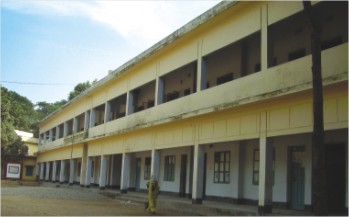| Guru Griho
From Sylhet
Sarkari Agragami Girls' High School now 104
Iqbal Siddiquee
 Established in 1903, Sarkari Agragami Girls High School is now 104 years old. The institution has, for all these years, been playing its role of creating better opportunities for women in society. The Srihatta Shammiloni, a forum of educated people from Sylhet living in Kolkata had a great role in establishing the institution. These young people decided that there was a great need for an all girls' school. Nineteenth century Bengal was going through many social changes at the time, a kind of renaissance. Social institutions were radically changing and women's schools were a big part of that change.
Established in 1903, Sarkari Agragami Girls High School is now 104 years old. The institution has, for all these years, been playing its role of creating better opportunities for women in society. The Srihatta Shammiloni, a forum of educated people from Sylhet living in Kolkata had a great role in establishing the institution. These young people decided that there was a great need for an all girls' school. Nineteenth century Bengal was going through many social changes at the time, a kind of renaissance. Social institutions were radically changing and women's schools were a big part of that change.
After much endeavor, Hemanta Kumari Chowdhury, wife of the then Special Sub-Registrar of Sylhet Raj Chandra Chowdhury, set up the school, greatly inspired by the spirit of Begum Rokeya. Back in 1903, the all-girls school was the first of its kind in Sylhet. For the first many years, it struggled to operate and get recognition. By 1929, however, the reputation of the school was solid.
The school's founder Hemanta Kumari Chowdhury (Hemanta Roy Chowdhury) was born in 1880 at her father's workplace in Punjab, where her father was working as a high government official. Hemanta was fluent in Bangla, English and Hindi. From the very beginning she took upon herself the responsibility of the Head Mistress and Secretary of the school committee. The school became an English high school in 1924. Hemanta is also the first woman magazine editor from Sylhet region. She was the editor of monthly magazine Auntopur, which started its publication in Kolkata in 1901. During the last days of her life, she went to Patiala to serve as Lady Superintendent of the Schools Department. She was also Commissioner of Deradoon Municipality. Hemanta Chowdhury, the pioneer and extremely active woman, died in India in 1952.
Subsequently, Sumati Majumder took over as the headmistress followed by Tarulata Barman and Labonya Probha. Rabeya Khatun, wife of great writer Syed Mujtaba Ali took over as the headmistress of the institution in 1948. Besides, renowned personalities like Luthfunnesa and litterateur Dr. Manjusri Chowdhury also served the school.
Kanak Purkayostha, a bright student of the school, stood first in the matriculation examinations from the then Calcutta University, which was holding the exams of the region including Assam. Kanak, equipped with the education from the school, led women in forming the Janaraksha Committee during the second world war. She died of chronic ailments in 1942.
Now, the school is running quite smoothly. 53 teachers are serving here in morning and day shifts. Abeda Begum had been leading the team as Headmistress. The number of students from Class III to class X in the school is 1900.
The school has a rich library. The girls do take part in the different extra curricular and cultural activities round the year. These include EPI camp, tree plantation programs, cleanliness campaign etc. There is also a students' contributory Red Crescent fund for extending help to the poor and meritorious students on a regular basis.
The school has about 4 acres of low land, attached to its present campus. The lands were acquired in 1960-61 for the extension of the school but these plans did not materialize. Furthermore, locals, due to the lack of concern on part of the authorities, simply grabbed much of the land.
Headmistress Abeda Begum told The Daily Star that the pressure in managing the school has increased throughout the years. The situation remains hard to control even after dividing the classes into morning and noon shifts, she added. Expansion of the institution has become a great demand of the growing city, which is now, of course, a divisional headquarter.
Copyright
(R) thedailystar.net 2007 |
